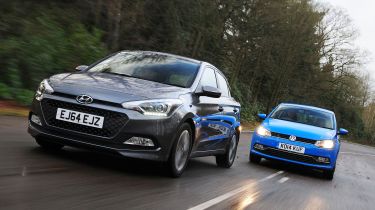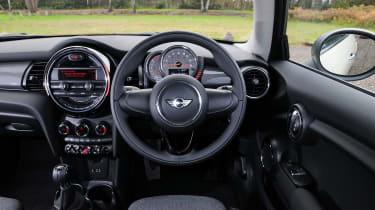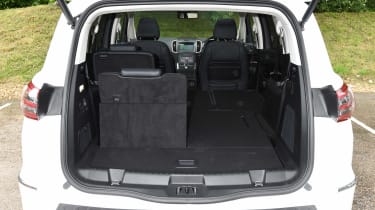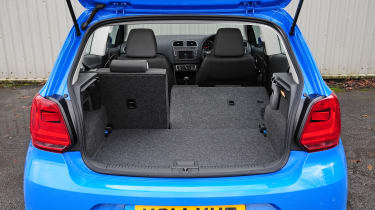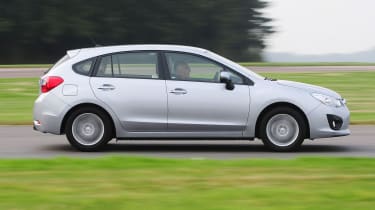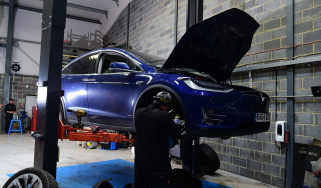Hyundai i20 vs VW Polo
All-new Hyundai i20 is one of the most practical superminis, but can it steal the class crown from the Volkswagen Polo?
The supermini class is one of the UK’s most fiercely fought, so any new car needs to be outstanding just to get noticed. And Hyundai has left no stone unturned to make its i20 a winner.
This new, second-generation model promises to add style, quality and desirability to the original’s reputation for value and a no-nonsense ownership experience.
Plus, as the new i20 is bigger than before, it’s now one of the most spacious and practical small cars around. Add the brand’s trademark five-year warranty, keen pricing and a range of efficient engines, and the car looks to have all the bases covered. Here we test it with a 1.4-litre CRDi diesel engine.
• Best superminis on the market
The supermini the i20 has to beat is the VW Polo. Recently revised and boasting class-leading refinement and quality, this small car really does think big. It’s quiet and comfortable, with the sort of hi-tech kit you’d normally expect on much larger and more expensive models.
This is the first time we’ve tested the diesel Polo, but the promise of extremely low running costs and grown-up driving dynamics should make it a tough opponent for the new i20.
Used - available now
Click the links above to read individual reviews, and scroll down to see which supermini comes out on top in this twin-test...
Head-to-head
Hi-tech kit
Both our contenders prove hi-tech kit is no longer the preserve of big executive saloons. However, it’s the Polo that leads the way with its superb £700 touchscreen sat-nav and £500 adaptive cruise control.
The Hyundai gets lane departure warning as standard, while the rather cheap-looking smartphone dock (below) is part of the £375 Driving Assistant pack, which also includes cornering headlamps and distinctive LED running lights.
Refinement
You’ll have no trouble guessing what type of engine powers the Polo. Start the three-cylinder diesel from cold and it sounds like there’s a pneumatic hammer under the bonnet. Our noise meter revealed it emitted 47dB at idle – 4dB louder than the i20. Still, the two cars were equally refined at speed.
Space race
The Hyundai is fractionally longer, wider and taller than the VW, so it’s no surprise it offers a bit more interior space. It has a bigger boot, too – when the seats are in place, there’s a very generous 301-litre capacity. Fold the rear bench flat and this increases to 1,017 litres, which is 65 litres up on the Polo.
Verdict
1st place: Hyundai i20
If you need a diesel supermini, the i20 is a better buy than the Polo. Its 1.4-litre engine is punchier, smoother and more economical. The Hyundai also benefits from handsome styling, a practical interior and decent refinement. The driving experience lacks sparkle and the ride is firm, but this is offset by value pricing and a long warranty. However, if we were testing petrol cars, this result would be reversed.
2nd place: VW Polo
The Polo is still our favourite supermini, but it’s badly let down in this encounter by the noisy and unrefined three-cylinder diesel. Not only does it lack the smoothness of rival engines, it’s a sluggish performer and can’t match VW’s impressive fuel economy claims. Unless you plan to do tens of thousands of miles a year, the smooth and punchy 1.2-litre TSI is a far better bet – plus it’s nearly as efficient.
Key specs
| Hyundai i20 1.4 CRDi SE | Volkswagen Polo 1.4 TDI SE | |
| On the road price/total as tested | £14,725/£15,595 | £15,425/£15,425 |
| Residual value (after 3yrs/36,000) | N/A | £7,527/48.8% |
| Depreciation | N/A | £7,898 |
| Annual tax liability std/higher rate | £499/£998 | £430/£861 |
| Annual fuel cost (12k/20k miles) | £1,308/£2,180 | £1,327/£2,212 |
| Ins. group/quote/road tax band/cost | 11/£314/B/£20 | 13/£299/A/£0 |
| Cost of 1st/2nd/3rd service | £449 (3yrs/30k) | £288 (2yrs) |
| Length/wheelbase | 4,035/2,570mm | 3,972/2,470mm |
| Height/width | 1,474/1,734mm | 1,453/1,682mm |
| Engine | 4cyl in-line/1,396cc | 3cyl in-line/1,422cc |
| Peak power/revs | 89/4,000 bhp/rpm | 74/3,000 bhp/rpm |
| Peak torque/revs | 240/1,500 Nm/rpm | 210/1,500 Nm/rpm |
| Transmission | 6-spd man/fwd | 5-spd man/fwd |
| Fuel tank capacity/spare wheel | 50 litres/foam | 45 litres/foam |
| Boot capacity (seats up/down) | 301/1,017 litres | 280/952 litres |
| Kerbweight/payload/towing weight | 1,280/410/1,100kg | 1,152/498/1,000kg |
| Turning circle | 10.2 metres | 10.6 metres |
| Basic warranty (miles)/recovery | 5yrs (unltd)/5yrs | 3yrs (60,000)/1yr |
| Service intervals/UK dealers | 10,000 miles (1yr)/162 | Variable/223 |
| Driver Power manufacturer/dealer pos. | 18th/13th | 19th/31st |
| NCAP: Adult/child/ped./assist/stars | N/A | 90/86/41/71/5 |
| 0-60/30-70mph | 11.8/12.6 secs | 13.4/14.1 secs |
| 30-50mph in 3rd/4th | 4.3/5.9 secs | 5.4/8.0 secs |
| 50-70mph in 5th/6th | 8.7/11.0 secs | 12.9 secs/N/A |
| Top speed/rpm at 70mph | 109mph/2,000rpm | 107mph/2,000rpm |
| Braking 70-0/60-0/30-0mph | 54.0/39.9/9.3m | 52.9/38.0/10.3m |
| Noise outside/idle/30/70mph | 63/44/59/67dB | 67/47/60/67dB |
| Auto Express econ (mpg/mpl)/range | 49.3/11.0/542 miles | 48.6/10.8/481 miles |
| Govt urban/extra-urban/combined | 57.6/80.7/68.9mpg | 70.6/91.1/83.1mpg |
| Govt urban/extra-urban/combined | 12.7/17.8/15.2mpl | 15.5/20.0/18.3mpl |
| Actual/claimed CO2/tax bracket | 154/106g/km/17% | 156/88g/km/14% |
| Airbags/Isofix/park sensors/camera | Six/yes/yes/no | Four/yes/£295/£240 |
| Automatic box/stability/cruise control | No/yes/yes | No/yes/£400* |
| Climate control/leather/heated seats | No/no/no | £380/no/£360* |
| Metallic paint/LED lights/keyless go | £495/no/no | £540/£900/no |
| Sat-nav/USB/DAB radio/Bluetooth | No/yes/no/yes | £700/yes/yes/yes |
